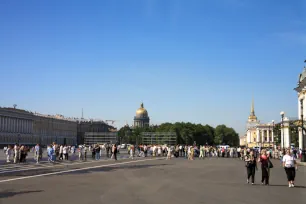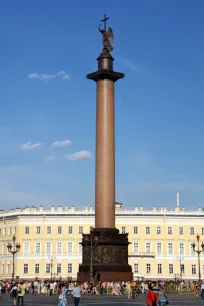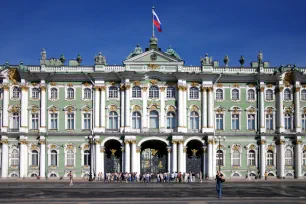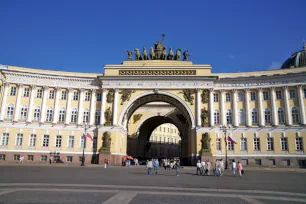The magnificent Palace Square forms the heart of historical St. Petersburg. Surrounded by some of the city’s most magnificent buildings, it is an architectural showcase and one of the prime tourist attractions in the city.
History


Palace Square was laid out in 1819-1829 by Carlo Rossi, a neoclassicist architect of Italian descent who designed many streets and squares in St. Petersburg. He was also responsible for one of the most monumental buildings along the square, the General Staff Building.
The square has a prominent place in the history of St. Petersburg. The massacre of ‘Bloody Sunday’ on January 22, 1905, when Tsarist troops fired on unarmed strikers, sparked the revolution of 1905. It also played an important part in the 1917 revolution, when a group of Bolshevik militants stormed the Winter Palace following a shot fired from the Aurora cruiser.
Today the enormous square is more peaceful. Locals often gather here, and tourists gaze at the architectural delights or stand in line for the Hermitage. Political rallies and official ceremonies still take place here, although today you’re more likely to see a concert or festival here.

Alexander Column
The star attraction of the square is the immense column that sits in its center. Known as the Alexander Column, it is a monument to Russia’s victory over Napoleonic France. Designed, ironically, by the French-born architect Auguste de Montferrand and built between 1830 and 1834, the column stands at 47.4 meters or almost 156 feet (including the base) and is topped with an angel whose face is said to resemble that of Emperor Alexander I. The monument, considered a great feat of engineering, weighs six hundred tons. No cranes were used to place it in the square!
Surrounding Buildings



The buildings around the Palace Square exhibit a variety of architectural styles and serve various purposes. On the northern side is the grand Baroque-style Winter Palace, built between 1754 and 1762. The main residence of the Russian Tsars, this palace sits on the banks of the Neva River and serves as the main building for the excellent Hermitage Museum. Originally built for Empress Elizabeth, daughter of Peter the Great, the Winter Palace was largely remodeled on the inside after a fire in 1837 destroyed large portions of the interior. Today, the Hermitage houses several millions of objects, and it would take years, literally, to see everything there.
On the southern side is a yellow and white building that served as the former home of the Imperial Army General Staff and now houses government offices. It was constructed between the years 1819 and 1829 from plans created by Italian architect Carlo Rossi. The 520 meter (1700 ft.) wide building includes a monumental central arch, designed as a double Triumphal Arch. During the Romanov era, grand armies would parade through the arch. The arch leads to Nevsky Prospekt, the major thoroughfare through the city of St. Petersburg.
On the eastern side of Palace Square is the former Royal Guards’ General Staff building, now used for various government offices as well. On the west, the square borders the Admiralty and the Admiralty Garden. The Admiralty was one of the first structures to be built in the city of St. Petersburg. Constructed between 1806 and 1823 from a design by Adrian Zakharov, the Admiralty was Russia’s naval headquarters until 1917 and now serves as a naval college. The gardens sit in front of the building and are especially beautiful in the spring and summer months.

